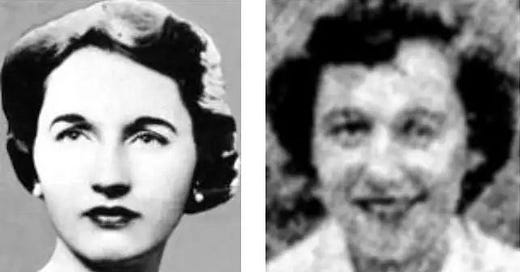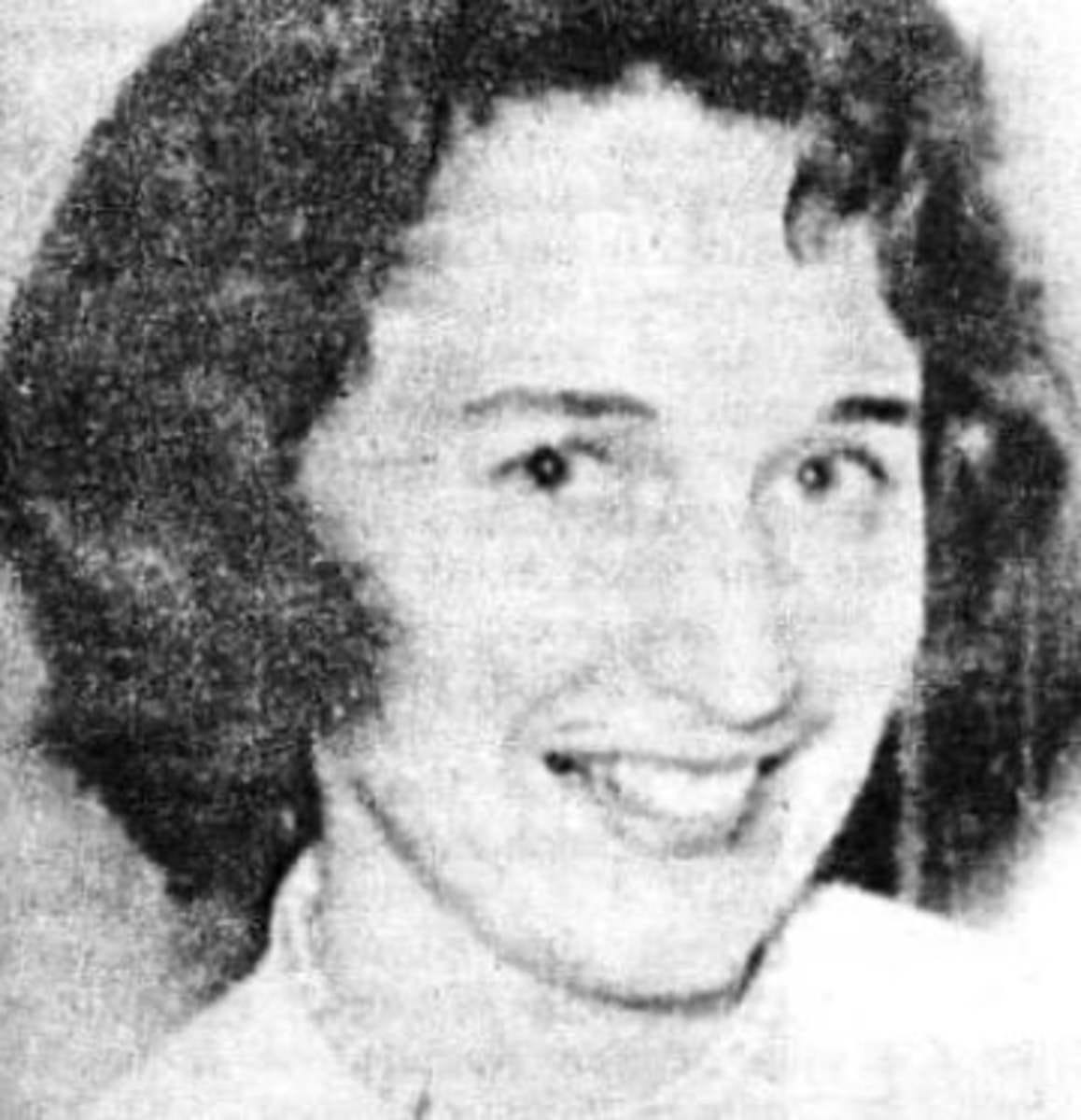The Bizarre Disappearance of Joan Risch
A woman vanishes under mysterious circumstances, leaving behind a bloody scene
A Puzzling Case
On October 24th, 1961, 31-year-old Joan Risch mysteriously vanished from her home, leaving behind a bloody scene. Her daughter Lillian returned from a playdate to find her mother missing and immediately went back to the neighbor’s house with the chilling words, “Mommy’s gone and the kitchen is covered with red paint.”
Several eyewitness reports indicated that a woman matching Joan’s description was seen that afternoon, wandering along streets disoriented and possibly injured.
Initially, it seemed obvious to law enforcement that Joan had been attacked and either fled the scene or had been abducted. However, bizarre details would soon come to light, hinting at another possibility—that she had staged her own disappearance.
What really happened to Joan Risch?
Joan Carolyn Risch
Joan Carolyn Bard was born on May 12th, 1930, in Brooklyn, New York, to parents Harold and Josephine. At eight years old, she and her family relocated to Mountain Lakes, New Jersey. Just one year later, tragedy would strike the family.
A fire broke out in the Bard apartment on February 23rd, 1939, killing Harold and Josephine. Joan, 9, was visiting relatives in Brooklyn at the time. While the fire was regarded as suspicious, the exact cause couldn’t be determined and the investigation into it was inconclusive. Ultimately, the fire chief deemed it an unfortunate accident.
Joan went to live with her aunt and uncle, who adopted her. Allegedly, she would later tell someone that her uncle had sexually abused her while she was growing up.
Described as kind, quiet and an avid reader, Joan excelled in school and graduated from Wilson College in Chambersburg, Pennsylvania, in 1952, obtaining a degree in English literature. From there, she pursued a career in the publishing industry, becoming a secretary (and eventually a supervisor) at Harcourt, Brace and World, and later Thomas Y. Crowell Co.
She began dating and went on to marry Martin Risch—an executive at her workplace—in 1956. The couple moved to Connecticut and had two children together, Lillian and David. After they got married, she quit working to become a homemaker and raise their growing family.
In April 1961, the Risches moved to Lincoln, Massachusetts. Martin secured a position with the paper company in Fitchburg and was often away on business. When Joan wasn’t caring for 4-year-old Lillian and 2-year-old David, she filled her time with hobbies like reading and joining the League of Women Voters. She dreamed of becoming a teacher one day when the children were older.
The Day Joan Vanished
On October 24th, 1961, Martin got up early and left for the airport, where he caught the 8 a.m. flight to New York City.
After having breakfast with the children, Joan took David over to neighbor Barbara Barker’s home, then she and Lillian traveled to the dentist's office in Joan's blue 1951 Chevrolet. Both she and her daughter had a dental appointment that morning. Afterwards, they went shopping.
Neither the milkman nor the mailman noticed anything odd at the Risch home that day.
Joan and Lillian returned to pick up David at approximately 11:15 a.m. and went back to the Risch residence. Shortly thereafter, a deliveryman for the local dry cleaner showed up to pick up Martin’s suits. He noticed nothing strange about Joan’s behavior or anything else going on inside the home that day.
Barbara brought her son Douglas, 4, over to play with Lillian at 1 p.m. During her time there, she noticed that Joan was pruning plants and then put her shears back in the garage. Still, everything seemed normal.
Just before 2 p.m., Joan brought Lillian over to Barker home once again, explaining that she’d be back soon. This is where things begin to take a mysterious turn.
At 2:15 p.m. Barbara witnessed Joan wearing a trench coat and hurriedly walking up the Risch driveway, seemingly carrying a red object from her vehicle to the garage. Barbara couldn’t tell what she had in her hands.
"It seemed to me as though she was talking to someone," Barbara would tell police.
This is the final confirmed sighting of Joan Risch.
A Bloody Scene
After 3 p.m., 14-year-old Virginia Keene, the daughter of another neighbor, got off the school bus and spotted an unfamiliar vehicle parked in the Risch driveway. She recalled that it might have been a General Motors model and that it was two-toned, with one of the colors being blue. The mailman would later state that he’d seen a similar vehicle parked at the home five days earlier.
However, by the time that Barbara brought Lillian home around 4:15 p.m., the mysterious car was gone. She left Lillian, who ran inside the home and found a shocking scene. Young Lillian ran back over to Barbara’s home, explaining that “Mommy’s gone and the kitchen is covered with red paint.”
Barbara was alarmed by the child’s story and quickly went back to the Risch residence to see what was going on. As Lillian had stated, Joan was no longer there, and there were what appeared to be smears of blood on the walls, floor and telephone. Frightened by her discovery, Barbara called the police at 4:33 p.m.
First on the scene was Sergeant Mike McHugh of the Lincoln Police Department. In addition to what has already been mentioned, he noticed that there was an overturned table and that the handset of the wall-mounted phone was in the trash. Strangely, it also looked as if an effort was made to clean up the blood using some of David’s clothing, as well as paper towels.
David himself was still safely inside his bedroom upstairs, but was crying because he needed a new diaper. Blood was found on both the top and bottom stairs, as well as in the master bedroom and on a window in the children’s room. Three bloody fingerprints were also discovered.
Additionally, a trail of blood led from the kitchen to the end of the driveway, leading investigators to speculate that Joan was either picked up or abducted. It was unclear in what part of the house her injury had been incurred. Interestingly, no bloody footprints were found anywhere.
Testing would reveal that the blood was type O–the same as Joan’s. However, this is also the most common blood type and it couldn’t be said definitively that it was hers, since they didn’t possess sophisticated technology for DNA analysis at this point. Yet it seemed likely to investigators that the blood was, in fact, Joan’s, all things considered.
Though the scene was alarmingly bloody, a state police chemist determined that the blood loss would have only amounted to approximately half a pint—in itself not indicative of a life-threatening wound.
Martin was contacted the same day about his wife’s disappearance and caught a flight back as soon as possible.
Strange Sightings
There were a number of unsettling reported sightings of a woman matching Joan’s description that afternoon.
At 2:45 p.m. this woman was spotted walking hunched over along the side of Massachusetts Route 2A.
Another eyewitness sighting, which occurred at sometime between 3:15-3:30 p.m., indicated that she appeared to be disoriented and injured, with blood running down her legs as she walked along Route 128. It also looked as if she was carrying something.
After these and a few similar sightings that afternoon, Joan Risch wasn’t seen again.
Interestingly, the mystery car was spotted on Sunnyside Lane around 4:15 p.m. The driver, a man, reportedly got out of the vehicle, cut some tree branches from the nearby woods and returned to his car with them.
Search
The police called hospitals, looking for Joan, and the staff of each was made aware that she was missing and evidently hurt.
Dogs were unable to track Joan's scent beyond the Barkers' property.
A search of the Lincoln area, on the ground and by helicopter, was fruitless.
Joan's Library Book Choices Raise Eyebrows
Police continued to believe that Joan had been attacked in the home, but new information would soon hint at an even stranger possibility.
Investigators soon learned that Joan had taken out 24 library books in recent months. On its own, this fact wasn’t odd at all, considering that Joan was known to be an avid reader. However, what gave detectives pause was the subject matter of these books and how closely some of it aligned with the narrative of Joan’s own disappearance.
According to the Boston Globe, the themes of these stories variously included “a wife disappearing without a trace,” “a man runs away to escape his troubles,” “a woman flees her home to start anew,” “an orphan girl vanishes,” and “a man stages his own disappearance.”
Into Thin Air was among the books that she’d taken out, which detailed the story of a woman who mysteriously vanished, leaving behind a bloody scene.
Law enforcement felt that her apparent recent fascination with strange missing persons cases—some strikingly similar to her own—could be more than just an incredible coincidence and that Joan might have staged her own disappearance. But why she would do this—if she did—remained a mystery.
Granted, many people read and enjoy books like that, but most don’t vanish in a way that so closely parallels the events of such stories, which is why it was of particular interest to investigators.
Still, it could be a red herring.
For his part, Martin was convinced that his wife was suffering from amnesia and that she’d return one day when she was able to remember her family again. However, Joan had no known history of mental health struggles, nor did anyone else in her family.
Bizarre Phone Calls
In early November, the Risch residence received at least a dozen bizarre phone calls. Martin's parents were staying over at the time to help take care of the children. The caller, an unidentified woman, repeatedly refused to speak to Martin's father.
Similarly, one of Joan's neighbors got a call from an agitated woman who complained that she kept trying to call her home, but couldn't get ahold of anyone she knew there. Soon thereafter, the calls stopped entirely.
Some have speculated that Joan herself might have been the caller, while others believe that this was merely a cruel prank perpetrated by someone else.
Impressions of the Risches
Those who knew Joan were unable to reconcile the idea of her running away with the person they knew, believing her incapable of doing such a thing and that foul play must have been involved.
In the wake of Joan’s mystifying disappearance, many friends, neighbors and acquaintances came forward to speak about Joan, as well as Martin.
“Both Mr. and Mrs. Risch were very friendly, but Mrs. Risch was more so,” said Virginia Keene.
“She was a slightly-built person, very quiet, unassuming and seemed quite content,” stated another resident.
Other locals described Joan as “reserved but friendly” and “not especially glamorous.”
“She was so reserved that it was difficult to get to know her,” said best friend Olga Madden. “I practically accosted her on the street when I first met her.”
Olga went on:
“We were very close. I miss her terribly.”
“She was innocent and friendly, a really nice person,” said Alice Wesley, another neighbor.
“Mrs. Risch never discussed her family or personal problems with me, but she appeared to be very happy,” said Dr. Theodore Safford Jr., the family physician, who also noted that the missing woman had been in excellent health.
Though she was said to be a devoted wife and mother, some of Joan’s friends revealed that she had confided in them that she missed working in the publishing industry and found domestic life unfulfilling.
“I think Joan is almost certainly dead,” asserted Sabra Morton, a friend. “She would never have left her family on her own.”
Herb Jones, an assistant personnel director at Martin’s company said that Martin was “an awfully nice guy, quiet and unassuming.”
Interestingly, some of Martin’s colleagues stated that they’d never met Joan and that Martin never spoke of her in the months that they’d been working together.
Mystery Fingerprints
The three bloody fingerprints found in the residence were determined not to belong to Joan, once again bringing the foul play theory to the forefront.
“We know someone else was there at that time,” explained District Attorney John J. Droney. “We know—because the bloody fingerprints were not those of Mrs. Risch. Our investigation turned up a set of Mrs. Risch’s fingerprints made several years ago. The bloody prints were not hers.”
Did they belong to her assailant? Or perhaps a co-conspirator? This was yet another question that would go unanswered.
More than 100 individuals, including salesmen, Lincoln area residents, and tradesmen were fingerprinted, but none proved to be a match.
Suspect: Robert Foster
A man named Robert Foster was identified as a person of interest early in the investigation, as some local residents called him to the attention of law enforcement. Foster was involved with a Congressional project which aimed to remove structures that had been built after 1775 from the area, with the intention of restoring the location to its historic aesthetic.
His role as a purchasing agent brought him to Lincoln, where he visited with many residents. He’d even been at the Risch home on September 25th. Several locals viewed his presence as an annoyance. However, aside from his apparent unpopularity, it’s unclear why they considered him a plausible suspect.
His alibi for that afternoon—lunch with his supervisor and then a meeting with a property appraiser—was confirmed by investigators and he was ruled out as a person of interest.
Later Developments
Thousands of leads would be checked out by investigators, but no evidence or substantial clues turned up.
Droney remained invested in Joan’s case—which he would refer to as “the most baffling” of his career—as did many others. Additionally, he came to agree with Martin’s theory that Joan was an amnesiac.
“I have a strong feeling she is. She was not the type of woman who would leave her children knowingly, and she and her husband were getting along fine. We’ve checked into his background and found he was a model husband and father and they were fond of each other.”
One detective believed that she might have suffered an accident at a nearby construction site, which was located along Route 128 at the time, and was unintentionally buried there.
Former police chief Leo Algeo continued to look into Joan’s case even after his retirement, eager to find a resolution. He called it “sort of a stone around (his) neck. I thought they’d find a body or bones or something… Things do turn up. People don’t disappear without a trace.”
Algeo, who passed away in 2009, had his own theory for what happened to Joan, but didn’t want to share it publicly.
Another theory that often comes up is the possibility that she underwent a botched abortion, though there was no evidence that she was pregnant. Additionally, Martin refuted this idea, certain that Joan would have been thrilled if she'd been pregnant again, although, as far as he knew, she wasn't. The police were also unable to find any proof that she had a lover.
Martin continued to live in their Lincoln, Massachusetts, home for years and raise their children. In 1975, the Risch house was purchased by the National Park Service, who was developing the region as a park, and relocated to Lexington, Massachusetts. Martin moved away after this and died in 2009, at the age of 79. He never remarried or had his wife declared legally dead.
Joan Risch's case is still open, but the lack of solid evidence or leads has left it at a standstill.









